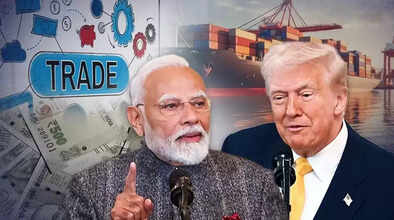India's strength or something else... Why is Trump unable to take the decision to impose tariffs on India?

Once again, US President Donald Trump had set a deadline of July 9 for tariffs, but this time India handled this deadline smartly and dealt with Trump's tariff pressure diplomatically. When Trump once again took a tough stand on the trade issue earlier this year and promised 90 deals in 90 days, it seemed that history would repeat itself. His threats and tariff warnings were an attempt to put pressure on America's major trade partners. But this time the world's response was different than before, and India was among the few countries that kept itself away from this tug-of-war.
After the July 9 deadline passed, Trump sent strict letters to many countries and warned them of imposing heavy tariffs, but India, which is a major exporter to the US and was also on Trump's target list, did not receive any such letter. This was not a coincidence, but the result of India's well-thought-out diplomacy. Indian officials said that the talks are still going on, which clearly shows that India's strategy has been successful in weakening Trump's threat of tariffs.
Response to pressure, but not confrontation
India's way of responding to Trump's pressure has been clear: talk, but don't bow down. Commerce Minister Piyush Goyal, who recently returned from Washington, had clearly said that India will not make any deal in a hurry in the name of any arbitrary deadline. This was not just for within India, but was also a clear signal to the US that India is ready for talks, but will make any agreement only on its terms.
The two foundations of this strategy are patience and preparation. India has kept the doors of talks open and has sent teams to Washington several times. Also, no provocative statements or such steps were taken that would increase tensions. The result was that India remained in the talks and did not appear weak or bow down.
However, the threat of Trump's tariffs remains, especially in the pharma sector. Trump had talked about imposing a duty of up to 200% on pharma imports, which could have caused a huge loss to India, as India is a major supplier of generic medicines to the US. Still, India has not received any formal threatening letter so far, while many other countries have received one. This means that Trump is hoping for a mini deal with India, which he can present as his victory, while talks with other countries are stuck. Not sending the letter is not just a formality, but a part of Trump's strategy. Trump knows that India can make a deal faster than Japan, South Korea, and Europe.
Why is India easy for Trump?
While other countries have become adamant, India has kept the door open for talks. Japan has clearly said that it will not reopen the bilateral trade deal of 2020. South Korea has also said that it wants large-scale concessions first. Europe has adopted a tough stand by calling Trump's threats a political drama.
On the contrary, India is actively negotiating, and another delegation will soon go to Washington. Special Secretary Rajesh Agarwal has also said that the talks are ongoing. He is the chief negotiator of the proposed India-US bilateral trade agreement. The effort is to complete the first part of this deal by September-October this year. Before this, both countries are trying to finalize an interim trade agreement.
Government sources told ANI that soon the Indian delegation will again go to Washington for face-to-face talks. Apart from this, many virtual meetings have also taken place in recent weeks. All this shows that India is ready for a deal, but on its terms. This is what attracts Trump towards India, which has not had any major success after the July 9 deadline. A limited agreement on pharma, digital commerce, and some agricultural products can also be a victory for Trump.
Trump's new deadline of August 1
Both sides are looking at a practical agreement. A very big free trade deal is not possible so soon, but a small agreement on some important sectors will be good for both. Trump can count it in his 90 deals and India can maintain its hold in the American market while protecting its interests like agriculture and dairy. It is not clear whether the deal will be done by the new deadline of 1 August or not. Trump himself has said that this deadline is not 100% fixed. This has allowed India to drag the talks, without coming under pressure.
Overall, quietly crossing the deadline of 9 July is a quiet but big diplomatic victory for India. India has shown that it can remain a strong partner without bowing down, without giving a fierce reaction. If India crosses even the soft deadline of 1 August and even then Trump does not send any threatening letter, it will prove that Trump is ready to give India those concessions which he does not give to other countries.
The coming weeks will be very important. If India manages to reach a limited agreement with the US on its own terms, it will be a testament to India’s diplomatic strength in the face of the world’s most erratic and aggressive leader.
Disclaimer: This content has been sourced and edited from TV9. While we have made modifications for clarity and presentation, the original content belongs to its respective authors and website. We do not claim ownership of the content.

